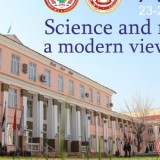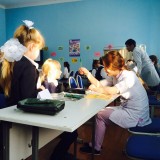New international scientific journal «Central Asian Journal of Medical Science and Education» in English
From 2015 Asfendiyarov Kazakh National Medical University launches new international scientific journal «Central Asian Journal of Medical Science and Education» in English.
The journal is an interactive platform for discussionof topical issues related to development of medicine, modern science and medical education.
The aim of the journal is a broad coverage of scientific achievements in the field of health and medical education, and a formation of scientific and clinical views among the target audience.
The journal publishes articles that have scientific and practical value for a wide range of medical specialists and covers different areas of medicine.
The journal publishes full-length original articles, reviews, lectures, practical recommendations to doctors, case studies and summaries of international congresses and conferences.
Editorial Board welcomes reviews that providean analysis of contemporary international publications addressing problem assessment.
Publication frequency: 1 time per quarter.
In this regard, we invite you to take part in the formation of the first issue of the international scientific journal «CAJMSE».
Sections:
- Medicine
- Pharmacy and Pharmacology
- Stomatology
- Public Health
- Educational process
Deadline: 17.08.2015
Articles and information about the author should be sent to the address of the editorial board:
E-mail: [email protected]
Submit papers should be treated according to the following recommendations:
General article’s requirements and information about the author
| Aplication form | «Application — name of the author» |
| Article | «Title of article — name of the author» |
| Typeoffiles | Microsoft Word 2003-2010 (doc) |
| Sheet size | А4 |
| Fields | top and bottom — 2.5 cm, left — 3 cm, right — 1.5 cm |
| Text alignment | by width |
| Paragraph (indent) | 1,25 см |
| Language | English |
| The uniqueness of article | Article should not occur in other printed media |
Application form (print and online)
| Surname, Name of authorSurname, Name co-authors | |
| Titleofarticle | |
| Section | |
| Department, university | |
| City, country | |
| Contact phone number and e-mail address |
Important Considerations
- Patient information must be ‘de-identified’
- Necessary approvals and consents should have been obtained
- Potential competing interests should be disclosed.
Making a title
| Titleofarticle | Font -Times New Roman 20, bold ;Text Alignment — Central |
| Theauthors, co-authors | Font — Times New Roman 12;Text Alignment — Central.Name,Surname, department, university, city, country, email (in the sequence) |
Abstract formalization
The abstract shouldbe afterthe title andbefore the article,consistsof 4short paragraphs:
- Background
- Methods
- Results
- Conclusion
| Font | For headlines of paragraphs — Times New Roman 10, uppercase, bold;For a summary of text — Times New Roman 10. |
| Colour | black |
| Word limit | 250 |
| Linespacing | 1,0 |
Keywords – up to 10 (selected from the MeSH of PubMed)
Article formalization
| The headlinesofparagraphs | Introduction (500-600 words);Methods (up to 800 words);Results (800-900 words);Discussion and conclusion (up to 1700 words);References (up to 40-50). |
| Font | For headlines of paragraphs — Times New Roman 12, uppercase, bold;For a summary of text — Times New Roman 12. |
| Colour | Auto |
| Word limit | 4000 |
| Linespacing | 1,0 |
| Tables, schemes, diagrams, illustrations | Coloured, black and white;Embedded in the text, signedThe maximum number — 6. |
| Formulas | Must be created in the embedded equation editor of Word. |
| References | Reference is placed at the end of the article, numbered |
Sections:
- Medicine
- Pharmacy and Pharmacology
- Stomatology
- Public Health
- Educational process
An example of the abstract, article and references
Use of potentially curative therapies for muscle-invasive bladder cancer in the United States: results from the National Cancer Data Base
Gray PJ1, Fedewa SA, Shipley WU, Efstathiou JA, Lin CC, Zietman AL, Virgo KS
1Department of Radiation Oncology, Massachusetts General Hospital, Boston, MA 02114, USA
Email: [email protected]
Abstract
BACKGROUND
Despite its lethal potential, many patients with muscle-invasive bladder cancer (MIBC) do not receive aggressive, potentially curative therapy consistent with established practice standards.
METHODS
To characterize the treatments received by patients with MIBC and analyze their use according to socio-demographic, clinical, pathologic, and facility measures.
Using the National Cancer Data Base, we analyzed 28 691 patients with MIBC (stages II-IV) treated between 2004 and 2008, excluding those with cT4b tumors or distant metastases. Treatments included radical or partial cystectomy with or without chemotherapy (CT), chemoradiotherapy (CRT), radiation therapy (RT), or CT alone and observation following biopsy. Aggressive therapy (AT) was defined as radical or partial cystectomy or definitive RT/CRT (total dose ≥ 50 Gy).
RESULTS
According to the database, 52.5% of patients received AT; 44.9% were treated surgically, 7.6% received definitive CRT or RT, and 25.9% of patients received observation only. AT use decreased with advancing age (odds ratio [OR]: 0.34 for age 81-90 yrvs ≤ 50 yr; p<0.001). AT use was also lower in racial minorities (OR: 0.74 for black race; p<0.001), the uninsured (OR: 0.73; p<0.001), Medicaid-insured patients (OR: 0.81; p=0.01), and at low-volume centers (OR: 0.64 vs high-volume centers; p<0.001). Use of AT was higher with increasing tumor stage (OR: 2.23 for T3/T4a vs T2; p<0.001) and nonurothelial histology (OR: 1.25 and 1.43 for squamous and adenocarcinoma, respectively; p<0.001). Study limitations include retrospective design and lack of information about patient and provider motivations regarding therapy selection.
CONCLUSION
AT for MIBC appears underused, especially in the elderly and in groups with poor socioeconomic status. These data point to a significant unmet need to inform policy makers, payers, and physicians regarding appropriate therapies for MIBC.
KEYWORDS: Bladder cancer, Genitourinary cancer, Bladder-sparing therapy, Radical cystectomy
INTRODUCTION
Despite continued reduction in high-risk behaviors such as tobacco consumption, cancer of the urinary bladder remains the fourth most common cancer in men in the United States with an estimated 73 510 new cases in both sexes diagnosed in 2012[1]. Approximately 25% of patients present with muscle-invasive disease at diagnosis [2]. While noninvasive bladder cancer can be effectively managed with transurethral resection of the bladder tumor (TURBT) or localized therapies such as intravesical bacillus Calmette-Guérin, muscle-invasive bladder cancer (MIBC) has a high propensity for rapid growth and distant spread if not managed aggressively.
METHODS
The NCDB, jointly sponsored by the American College of Surgeons and the American Cancer Society, is a hospital-based cancer registry that serves as a comprehensive, clinical, surveillance resource for cancer care in the United States [3] and[4]. The NCDB captures approximately 75% of new cancers in the United States each year. Datacodingmethodshavebeendescribedpreviously.
RESULTS
Treatments received by the 28 691 patients analyzed are shown in Table 1. RC without the use of pre- or postoperative CT was the most common treatment received (28.7%). Neoadjuvant CT was used in only 1.9% of cases; adjuvant CT was recorded in 10.7% of patients. Only 3.7% of patients underwent PC and the use of CT with PC was rare. In total, 44.9% of patients received some form of open or laparoscopic surgical therapy.
DISCUSSION AND CONCLUSION
This study provides further insight into the treatment of patients with MIBC in the United States. AT in line with established practice guidelines are significantly less likely to be received by the elderly, racial minorities, those with inadequate insurance coverage, and patients seen at low-volume centers. Our study is the largest to date to fully explore the variety of treatments used for patients with MIBC in this century and can be used to inform payers, policy makers, and physicians regarding the appropriate selection of treatments for patients with MIBC.
REFERENCES
- Author AA, Author BB, Author, CC. Title of article.
Title of Journal. 2005;10(2):49-53.
- Author AA, Author BB, Author, CC. Title of article.
Title of Journal. 2005;10(2):49-53.
- Author AA, Author BB, Author, CC. Title of article.
Title of Journal. 2005;10(2):49-53.
- Author AA, Author BB, Author, CC. Title of article.
Title of Journal. 2005;10(2):49-53.











